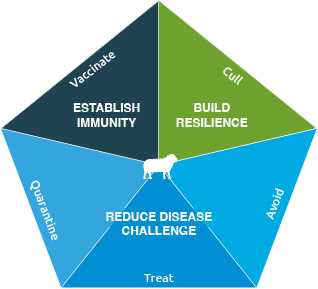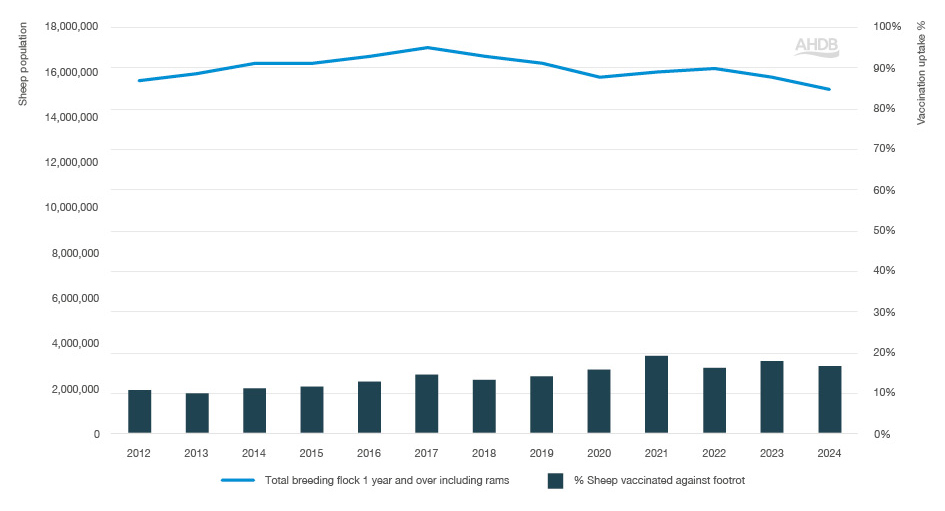- Home
- Knowledge library
- Footrot vaccinations in sheep
Footrot vaccinations in sheep
Footrot vaccination has a part to play in flock management to reduce the incidence of lameness in sheep.
Lameness in sheep flocks is one of the most common and persistent disease problems.
There are three common infectious causes of lameness:
- Scald (interdigital dermatitis) is caused by the bacteria Dichelobacter nodosus
- Footrot is caused by the bacteria Dichelobacter nodosus
- Contagious ovine digital dermatitis (CODD) is thought to be caused by Treponema bacteria
It is unrealistic to expect that a flock will never have lame sheep, but it is important that you understand the infectious nature of lameness so that effective control can prevent the number of cases from escalating.
The overall cost of lameness in a flock is estimated to be between £3.90 and £6.35 per ewe per year (Winter and Green, 2017) and costs the national flock an estimated £24m annually (Nieuwhof and Bishop, 2005).
The five point plan (Clements R. H., 2014) is the current sheep industry-accepted standard for lameness control.
The plan summarises the tools that are available for lameness control in sheep flocks.
To gain the most benefit, consider all points of the plan for your flock.
The five-point plan
1. Cull badly or repeatedly affected animals.
2. Quarantine incoming animals.
3. Treat clinical cases promptly (within 3 days).
4. Avoid transmission of infection on farm.
5. Vaccinate against footrot.
With the majority (two-thirds) of antibiotics used on sheep farms considered to be used in the control of infectious lameness (Davies, 2017), improved lameness control is one of three hotspot areas for the reduction of antibiotics in the sheep industry, as identified in the RUMA Targets Task Force Report 2020.
Figure 1. The five-point plan

Footrot vaccination
Only one footrot vaccine is commercially available:
- Footvax® is a vaccine for the active immunisation of sheep as an aid to the prevention of footrot and reduction of lesions of footrot caused by serotypes of D. nodosus
It has been estimated that footrot vaccination reduces the prevalence of footrot by 20–62% (Winter J.R., 2015) (Duncan, 2012).
Evidence suggests that lameness prevalence is lower in flocks that have been vaccinating against footrot for more than five years compared to flocks that do not vaccinate (Prosser, 2019) (Best, 2020).
Discuss with your vet whether vaccination would be beneficial for your flock.
Read more about footrot vaccination
Assumptions
Numerator
The number of doses of vaccine administered has been calculated by multiplying the number of packs sold by the number of doses per pack.
Denominator
Although there are flocks for which lameness is well controlled and footrot vaccination is not necessary, for the purposes of this report, the denominator was calculated on the assumption that all ewes intended for first-time breeding received two doses of vaccine as a primary course and that older ewes are vaccinated at least once a year.
Rams appear to be particularly susceptible to infectious lameness and since the mobility of rams is critical to their breeding performance, it is assumed that all rams are vaccinated for footrot twice a year.
The total number of vaccine doses that would be required to help prevent footrot in the national UK flock has been estimated based on the assumption that all ewes intended for first-time breeding and all rams receive two doses of vaccine, and that all ewes intended for further breeding or slaughter receive an average of one dose.
Ewes that are culled without being vaccinated are likely to be balanced by those ewes receiving additional doses in times of higher risk.
Vaccination uptake
In 2024, it was estimated that 17% of the breeding flock was vaccinated for footrot – this is a slight decrease from 18% in 2023.
Figure 2. Percentage of sheep vaccinated against footrot


